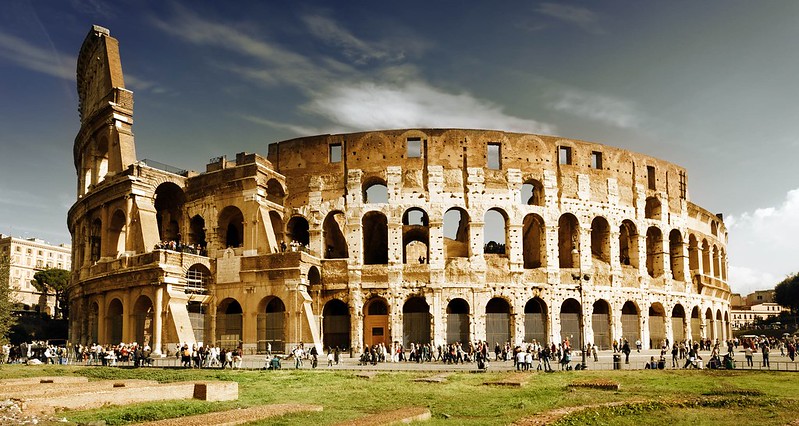The Marvel of the Roman Empire: The Colosseum

- Country:
- Italy
One of the seven wonders and greatest architectural and engineering marvels ever built by humans is the Colosseum. This massive structure is the symbol of Imperial Rome and still stands today in the center of the city of Rome, Italy, despite being 1900 years old. There are many interesting stories and facts about one of the seven wonders of the world.
The Colosseum is an oval-shaped ancient Roman Amphitheatre that was built under the reign of three different emperors of the Flavian dynasty. Its construction began in 72 AD under Emperor Vespasian and was completed in 80 AD by his successor and heir, Titus. Further modifications were made to the structure during the reign of Domitian, the younger son of Emperor Vespasian. As it was built under the reign of three emperors of the Flavian dynasty, hence it was named Flavian Amphitheatre.
Unlike many Roman theatres, it is a free-standing structure made of travertine limestone, tuff (volcanic rock), and brick-faced concrete, built on a flat land area on the floor of a low valley between the Caelian, Esquiline, and Palatine Hills. It is believed that close to 100,000 slaves worked every day for 8 years to complete the structure in 80 AD.
During its prime time, it was believed to have held an estimated 50,000 to 80,000 spectators with an average of 65,000 audiences at a time, and a total of 80 entrances were made for easy access to the arena. The famous Amphitheatre was built for the entertainment purpose of the citizens of the Roman empire. The first games were held under the reign of the emperor Titus in 80 AD, and the Amphitheatre was filled with water for the re-enactment of a famous sea battle between the Corcyrean (Corfiot) Greeks and the Corinthians. The seating inside was arranged according to class, citizenship, and sometimes even gender. The emperor and his entourage had a different entrance than the rest of the citizens with a specific seating area. The civilians were seated on hundreds of steps according to their class. Whereas, non-citizens and slaves were made to stand on the erected terraces, that exist no longer today.
In the early 1000s, the Flavian Amphitheatre due to its colossal size got its now famous name the Colosseum, by the people of the city of Rome. For close to 400 years, slaves of the Roman emperors fought as Gladiators with animals to showcase their courage and valor on the pretext of getting freedom if they won. The battles between humans and animals sometimes even lasted for over 100 days. Apart from gladiatorial fights, it also exhibited public spectacles like animal hunting, executions, re-creations of famous battles, and dramas based on Roman mythologies.
An estimated 500,000 human lives and close to a million animal lives were lost for the entertainment of the Roman empire and its citizens. Animals from all over the world were brought in for fights including bears, elephants, rhinos, giraffes, and tigers. The Hippos of the Nile river became extinct after particularly one brutal set of games that witnessed the killing of over 9000 animals. It is also the reason for the wiping of the North African Elephant off the face of the planet.
After lasting for over four centuries, the gladiator contests were stopped in 435 AD, and the last animal hunts were in 532 CE because of the high maintenance cost of the animals and the slaves. Later on, it was reused for the purpose of housing, workshops, quarters for a religious order, a fortress, a quarry, and a Christian shrine.
The great ancient Amphitheatre got damaged over time, and very little of the original arena remains visible to the world today. The first tragedy struck the Colosseum in the year 217 when a major fire (due to lightning, as per Dio Cassius) broke out that destroyed the wooden upper levels of the Amphitheatre’s interior. As per inscription records, the restoration of the Colosseum was carried out under Theodosius II and Valentinian III (reigned 425–455), possibly to repair damage caused by a major earthquake in 443. More severe damage was inflicted to the Colosseum in 1349 by the great earthquake, causing the outer south side to collapse which was built on a less stable alluvial terrain. Much of the leftover tumbled stone was reused to build palaces, churches, hospitals, and other buildings elsewhere in Rome.
In popular culture, the Colosseum has appeared in numerous films, artworks and games. The ancient Amphitheatre has been featured in movies such as Gladiator, The Core, Jumper, The Way of the Dragon, and Roman Holiday, and in games like Assassin's Creed: Brotherhood, Ryse: Son of Rome, and Forge of Empires.
Several modern architectural works show a hint of inspiration from the Colosseum in their construction. Some of the most famous architectural structures are The Kongresshalle, or "Congress Hall", (1935, unfinished) at the Nazi Party Rally grounds, Nuremberg, Germany, The Summer Olympic Games medal from 1928 to 2000, designed by Giuseppe Cassioli, features a depiction of the Colosseum, the exterior of the Vancouver Public Library in British Columbia resembles the current state of the Colosseum, The Los Angeles Memorial Coliseum entrance was inspired by the Colosseum, and McCaig's Tower, overlooking Oban, Scotland.
The Colosseum is a world heritage site, and it offers a great amount of information about the ancient Roman empire and the ancient culture they followed. Millions of people from around the world visit the city of Rome just to experience the grandeur of the colossal Amphitheatre today.
ALSO READ
Italy PM Giorgia Meloni calls surrogacy "inhuman"
Italy open to new G7 sanctions on Israel's enemies, foreign minister says
French bid to host 2030 Winter Olympics talks with Italy, Netherlands to stage speed skating
Italy open to new G7 sanctions on Israel's enemies, says foreign minister
Italy foreign minister calls on Israel to halt military operations in Gaza










